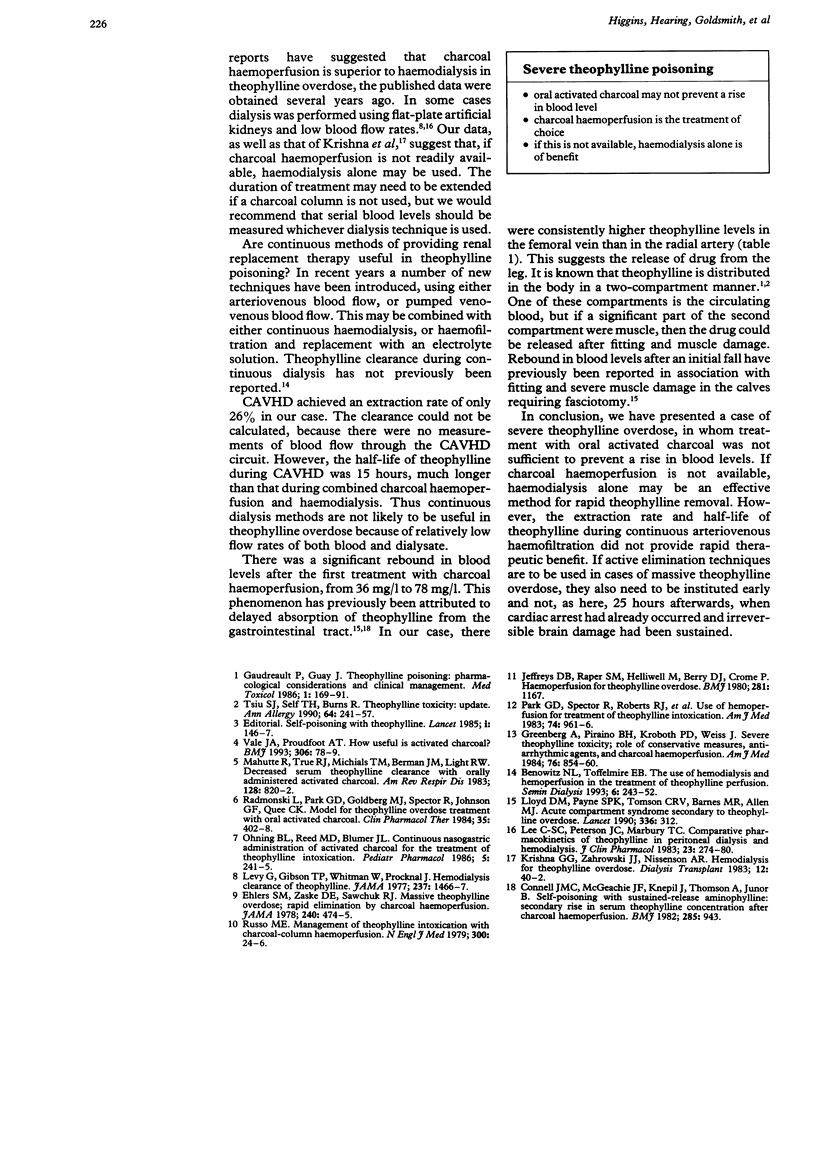Abstract
Theophylline poisoning with a blood level of 183 mg/l in a 38-year-old man was treated with activated charcoal by mouth, but despite this the blood level of theophylline rose and there was circulatory collapse with rhabdomyolysis, acute renal failure and hyperthermia. Treatment with charcoal haemoperfusion and simultaneous haemodialysis was given, followed by continuous arteriovenous haemodialysis (CAVHD). Mean extraction rates of theophylline were 26% during CAVHD, and 86% during combined dialysis and charcoal haemoperfusion. During combined treatment, the mean extraction rate of haemodialysis was 62%, compared with 48% for charcoal haemoperfusion. In summary, activated charcoal given by mouth may be unable to prevent a rise in blood levels and the development of complications after substantial theophylline overdose. If theophylline is to be removed from the blood, a combination of charcoal haemoperfusion and haemodialysis will give the best clearance, but haemodialysis alone may be effective.
Full text
PDF


Selected References
These references are in PubMed. This may not be the complete list of references from this article.
- Connell J. M., McGeachie J. F., Knepil J., Thomson A., Junor B. Self-poisoning with sustained-release aminophylline: secondary rise in serum theophylline concentration after charcoal haemoperfusion. Br Med J (Clin Res Ed) 1982 Mar 27;284(6320):943–943. doi: 10.1136/bmj.284.6320.943. [DOI] [PMC free article] [PubMed] [Google Scholar]
- Ehlers S. M., Zaske D. E., Sawchuk R. J. Massive theophylline overdose. Rapid elimination by charcoal hemoperfusion. JAMA. 1978 Aug 4;240(5):474–475. doi: 10.1001/jama.240.5.474. [DOI] [PubMed] [Google Scholar]
- Gaudreault P., Guay J. Theophylline poisoning. Pharmacological considerations and clinical management. Med Toxicol. 1986 May-Jun;1(3):169–191. doi: 10.1007/BF03259836. [DOI] [PubMed] [Google Scholar]
- Greenberg A., Piraino B. H., Kroboth P. D., Weiss J. Severe theophylline toxicity. Role of conservative measures, antiarrhythmic agents, and charcoal hemoperfusion. Am J Med. 1984 May;76(5):854–860. doi: 10.1016/0002-9343(84)90997-5. [DOI] [PubMed] [Google Scholar]
- Jefferys D. B., Raper S. M., Helliwell M., Berry D. J., Crome P. Haemoperfusion for theophylline overdose. Br Med J. 1980 May 10;280(6224):1167–1167. doi: 10.1136/bmj.280.6224.1167. [DOI] [PMC free article] [PubMed] [Google Scholar]
- Lee C. S., Peterson J. C., Marbury T. C. Comparative pharmacokinetics of theophylline in peritoneal dialysis and hemodialysis. J Clin Pharmacol. 1983 Jul;23(7):274–280. doi: 10.1002/j.1552-4604.1983.tb02735.x. [DOI] [PubMed] [Google Scholar]
- Levy G., Gibson T. P., Whitman W., Procknal J. Hemodialysis clearance of theophylline. JAMA. 1977 Apr 4;237(14):1466–1467. [PubMed] [Google Scholar]
- Lloyd D. M., Payne S. P., Tomson C. R., Barnes M. R., Allen M. J. Acute compartment syndrome secondary to theophylline overdose. Lancet. 1990 Aug 4;336(8710):312–312. doi: 10.1016/0140-6736(90)91847-4. [DOI] [PubMed] [Google Scholar]
- Mahutte C. K., True R. J., Michiels T. M., Berman J. M., Light R. W. Increased serum theophylline clearance with orally administered activated charcoal. Am Rev Respir Dis. 1983 Nov;128(5):820–822. doi: 10.1164/arrd.1983.128.5.820. [DOI] [PubMed] [Google Scholar]
- Ohning B. L., Reed M. D., Blumer J. L. Continuous nasogastric administration of activated charcoal for the treatment of theophylline intoxication. Pediatr Pharmacol (New York) 1986;5(4):241–245. [PubMed] [Google Scholar]
- Park G. D., Spector R., Roberts R. J., Goldberg M. J., Weismann D., Stillerman A., Flanigan M. J. Use of hemoperfusion for treatment of theophylline intoxication. Am J Med. 1983 Jun;74(6):961–966. doi: 10.1016/0002-9343(83)90790-8. [DOI] [PubMed] [Google Scholar]
- Radomski L., Park G. D., Goldberg M. J., Spector R., Johnson G. F., Quee C. K. Model for theophylline overdose treatment with oral activated charcoal. Clin Pharmacol Ther. 1984 Mar;35(3):402–408. doi: 10.1038/clpt.1984.50. [DOI] [PubMed] [Google Scholar]
- Russo M. E. Management of theophylline intoxication with charcoal-column hemoperfusion. N Engl J Med. 1979 Jan 4;300(1):24–26. doi: 10.1056/NEJM197901043000107. [DOI] [PubMed] [Google Scholar]
- Tsiu S. J., Self T. H., Burns R. Theophylline toxicity: update. Ann Allergy. 1990 Feb;64(2 Pt 2):241–257. [PubMed] [Google Scholar]
- Vale J. A., Proudfoot A. T. How useful is activated charcoal? BMJ. 1993 Jan 9;306(6870):78–79. doi: 10.1136/bmj.306.6870.78. [DOI] [PMC free article] [PubMed] [Google Scholar]


